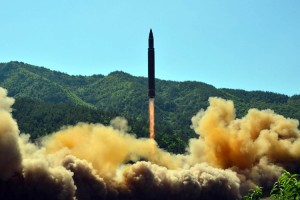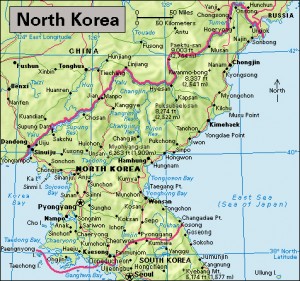Peril on the Korean Peninsula
October 26, 2017
On Sept. 19, 2017, in his first address to the United Nations (UN) General Assembly in New York City, United States President Donald Trump issued a stunning pronouncement regarding North Korea. If the United States was forced to defend itself or its allies against North Korean aggression, Trump told world leaders, “we will have no choice but to totally destroy North Korea.” Trump’s belligerent rhetoric—widely criticized by other world leaders—was the latest volley in a war of words between the two countries in which Kim Jong-un, North Korea’s leader, had earlier threatened to destroy the U.S. Pacific Islands territory of Guam. North Korea’s official name is the Democratic People’s Republic of Korea.

In a show of defiance on Independence Day in the United States, North Korea launches a ballistic missile into the Sea of Japan on July 4, 2017. Credit: © STR/AFP/Getty Images
Tensions between North Korea and the United States have risen steadily since Trump’s inauguration in January 2017. During the year, North Korea escalated its fledgling nuclear weapons program, testing ballistic missiles and conducting earth-shaking nuclear tests in the face of worldwide disapproval. Prior to Trump, U.S. presidents had taken a more diplomatic approach toward North Korean threats, noting that while the United States was militarily capable of overpowering the North, the human cost of such destruction would be too high. Caught in the war of words was South Korea, a traditional U.S. ally that was itself trying to negotiate a long-simmering feud with its northern neighbor. South Korea’s official name is the Republic of Korea.

Click to view larger image
A line roughly along the 38th parallel of north latitude separates North and South Korea. Credit: WORLD BOOK map
In 1948, the Korean peninsula was divided into the U.S.-backed democratic nation of South Korea and the Communist country of North Korea, which was supported by China and the Soviet Union. Both Korean governments claimed to represent all Korea. From 1950 to 1953, they fought for control of the peninsula in a bloody conflict known as the Korean War. Neither side won complete victory, and an armistice ended the fighting in July 1953. The United States, which fought with South Korea in the conflict, has stationed troops in the country ever since, and tensions between the Koreas have remained high. To this day, a demilitarized zone runs along the the 38th parallel of north latitude, keeping the bitter enemy countries apart.
Since the war, North Korea’s dynasty of dictators—Kim Il-sung, followed by Kim Jong-il, and his son Kim Jong-un—have kept the country isolated and at odds with much of the rest of the world. A nuclear weapons program started under Kim Jong-il was halted by an international agreement in 1994, but North Korea resumed the program in 2003. Kim Jong-un, who gained power in 2011, continued to develop North Korea’s nuclear weapons program, further increasing the nation’s problematic relations with the rest of the world.
North Korea intensified its nuclear weapons program in 2017. In February, the country began a series of missile tests. Experts believed the missiles were designed to deliver a nuclear warhead, and some appeared to be powerful enough to reach the west coast of the United States. In March, the United States began deploying a missile defense system in South Korea to defend the South and nearby allies from Northern missile strikes. In early August, North Korea announced it was developing a plan to launch missiles at Guam, home to large U.S. Air Force and Navy bases. President Trump threatened to retaliate with “fire and fury” if North Korea attacked.
On August 29, North Korea fired a missile over Hokkaido, the northernmost island of Japan. (Japan, a close U.S. ally, also hosts U.S. military bases.) The missile firing drew strong international criticism—something that only added fuel to North Korea’s fire. In early September, the “rogue nation” (a nation that ignores international law) further worried the world by detonating a hydrogen bomb, threatening to reduce the U.S. mainland to “ashes and darkness,” and firing another missile over Hokkaido.
In the days following Trump’s September 19 address to the UN General Assembly, he and Kim exchanged insults, threatening increased military action and accusing each other of being mentally deranged. North Korean Foreign Minister Ri Yong-ho accused Trump of declaring war on his country, saying North Korea had the right to shoot down U.S. warplanes.
China, a traditional North Korean ally, has distanced itself from its troublesome neighbor. Yet China has much to lose in a potential conflict, and the nation remains a vitally interested spectator. China’s foreign ministry spokesman, Lu Kang, advised caution in late September: “We hope the U.S. and North Korean politicians have sufficient political judgment to realize that resorting to military force will never be a viable way to resolve the peninsula issue.”


